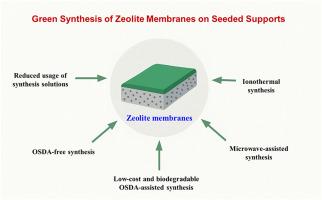Recent progress in the green synthesis of zeolite membranes
IF 4.7
3区 材料科学
Q1 CHEMISTRY, APPLIED
引用次数: 0
Abstract
Zeolite membranes have attracted much attention due to their regular and uniform pore structure and good thermal stability, and have attracted much attention in application fields such as gas separation and solvent dehydration. The traditional hydrothermal synthesis of zeolite membranes usually requires a large amount of synthesis solution or gel, relies on expensive and potentially dangerous organic structure directing agents (OSDAs), and involves a long crystallization time and high operating pressure. These factors lead to large resource consumption, significant chemical waste, and pose environmental and safety hazards. In recent years, with the growing interest in developing green and sustainable zeolite membrane synthesis routes to overcome these limitations, it has gradually become a research hotspot in this field. This review summarizes and discusses recent advances in the green synthesis of zeolite membranes from several aspects, including reduced quantity of synthesis solutions or gels, OSDA-free synthesis, low-cost and biodegradable OSDA-assisted synthesis, microwave-assisted synthesis, and ionothermal synthesis and outlines future development prospects in this field.

沸石膜绿色合成研究进展
沸石膜以其规则均匀的孔隙结构和良好的热稳定性而备受关注,在气体分离、溶剂脱水等应用领域备受关注。传统的水热合成沸石膜通常需要大量的合成溶液或凝胶,依赖于昂贵且具有潜在危险的有机结构导向剂(OSDAs),并且结晶时间长,操作压力高。这些因素导致资源消耗大,化学废物多,并造成环境和安全隐患。近年来,随着人们对开发绿色可持续的沸石膜合成路线的兴趣日益浓厚,以克服这些局限性,逐渐成为该领域的研究热点。本文从减少合成溶液或凝胶用量、无osda合成、低成本和可生物降解的osda辅助合成、微波辅助合成、离子热合成等方面综述和讨论了近年来沸石膜绿色合成的研究进展,并展望了该领域的发展前景。
本文章由计算机程序翻译,如有差异,请以英文原文为准。
求助全文
约1分钟内获得全文
求助全文
来源期刊

Microporous and Mesoporous Materials
化学-材料科学:综合
CiteScore
10.70
自引率
5.80%
发文量
649
审稿时长
26 days
期刊介绍:
Microporous and Mesoporous Materials covers novel and significant aspects of porous solids classified as either microporous (pore size up to 2 nm) or mesoporous (pore size 2 to 50 nm). The porosity should have a specific impact on the material properties or application. Typical examples are zeolites and zeolite-like materials, pillared materials, clathrasils and clathrates, carbon molecular sieves, ordered mesoporous materials, organic/inorganic porous hybrid materials, or porous metal oxides. Both natural and synthetic porous materials are within the scope of the journal.
Topics which are particularly of interest include:
All aspects of natural microporous and mesoporous solids
The synthesis of crystalline or amorphous porous materials
The physico-chemical characterization of microporous and mesoporous solids, especially spectroscopic and microscopic
The modification of microporous and mesoporous solids, for example by ion exchange or solid-state reactions
All topics related to diffusion of mobile species in the pores of microporous and mesoporous materials
Adsorption (and other separation techniques) using microporous or mesoporous adsorbents
Catalysis by microporous and mesoporous materials
Host/guest interactions
Theoretical chemistry and modelling of host/guest interactions
All topics related to the application of microporous and mesoporous materials in industrial catalysis, separation technology, environmental protection, electrochemistry, membranes, sensors, optical devices, etc.
 求助内容:
求助内容: 应助结果提醒方式:
应助结果提醒方式:


